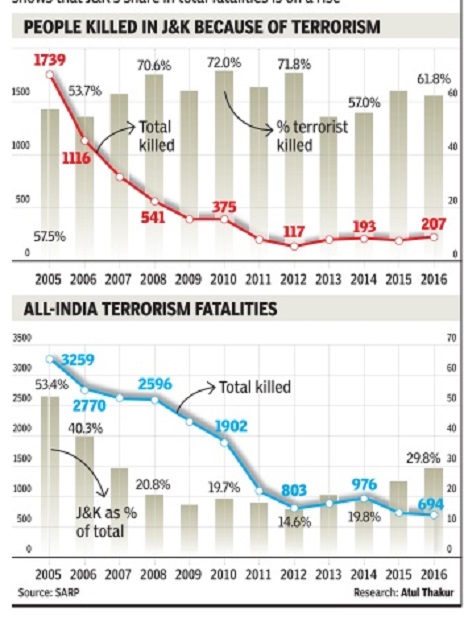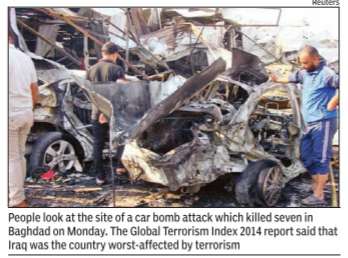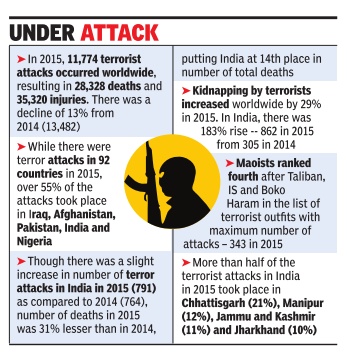Terrorism in India
This is a collection of articles archived for the excellence of their content. |
Contents |
History
1885-1947: a backgrounder
Dhananjay Mahapatra, May 27, 2019: The Times of India
Nathuram Godse murdered Mahatma Gandhi on January 30, 1948, because of his skewed perception that Gandhiji’s policies would accentuate appeasement of Muslims. Did that perception take root only because of the Calcutta killings of 1946, Naokhali riots and Gandhiji’s fast to force the government to reverse its decision not to give Rs 55 crore to Pakistan in the aftermath of invasion of Kashmir in 1947?
Let’s examine the political and social atmosphere that gradually weighed heavy on the Indian freedom struggle, a trailer of which premiered during the 1857 sepoy mutiny.
Before we delve into it, we must understand what it means to terrorise the masses. The word ‘terrorist’ was nonexistent during the freedom struggle, at least from an Indian perspective. When terrorism was at its peak in Punjab and Kashmir and its bloody footprints smeared the social fabric in northern states, the Rajiv Gandhi government enacted three anti-terror legislations in 1984, 1985 and 1987, referred to as TADA Acts.
In Kartar Singh vs State of Punjab [1994(3) SCC 569], the SC upheld the constitutional validity of TADA, which defined a terrorist as a ‘person who indulges in wanton killing of persons or in violence or in disruption of services or means of communications essential to the community or damages properties with a view to putting public in fear; affecting adversely harmony between different religions, racial, language or religious groups or communities; or coercing or overawing government established by law, or endangering the sovereignty and integrity of India”. POTA enacted by the Vajpayee government in 2002 had a similar definition. The SC upheld POTA’s constitutional validity in People’s Union for Civil Liberties [2003 (10) Scale 967] case. We do not know whether it would be fair to use the modern definition of ‘terrorism’ to judge speeches of tall leaders during the freedom struggle, but it would give some insight as to why a section of the population developed a sense of outrage against Muslim ‘appeasement’. In the 1880s, English educated Indians rallied around two personalities — Surendranath Banerjea in Calcutta and Allan Octavian Hume in Bombay. Hume held a congregation — Indian National Congress — in Bombay in December 1885. Womesh Chandra Bonnerjee was elected president. A miffed Surendranath floated the Indian National Conference. Hume’s negotiation saw Surendranath merge his outfit with INC in 1886.
Riled by the INC cold shouldering him, Sir Syed Ahmed Khan, who had held the post of a subordinate judge and established the Muhammadan Anglo-Oriental College in Aligarh in 1875, summoned a congregation of Muslims in Meerut in March 1888 and castigated the English-educated Bengalis for ignoring Muslims in Congress. He laid the foundation for the two-nation theory.
“It is incumbent upon me to show what evils would befall my nation from joining in the opinions of the Bengalis,” he had said while lashing out at Badruddin Tyabji for being part of INC in 1885.
He said respect for Muslim religious rites was sine qua non for Hindus to live trouble free. “When an agitation was started against cow killing, the sacrifice of cows increased enormously, and religious animosity grew on both sides, as all who live in India know well. They should understand that those things which can be done by friendship and affection cannot be done by any pressure of force,” Khan had said. On the British leaving India, Khan said, “Is it possible that under these circumstances, two nations — the Muhammedans and the Hindus — could sit on the same throne and remain equal in power? Most certainly not. It is necessary that one of them should conquer the other and thrust it down. To hope that both would remain equal is to desire the impossible and the inconceivable.”
Khan’s aggressive tone turned intimidating while telling the congregation that Muslims’ numbers in India may be less than that of Hindus but that should not make them feel insignificant or weak. “Probably they would be by themselves enough to maintain their own position. But suppose they were not, then our Musalman brothers, the Pathans, would come out as a swarm of locusts from their mountain valleys, and make rivers of blood to flow from their frontiers on the north to the extreme end of Bengal,” he said.
Sixty years later, rivers of blood did flow in Bengal on August 6, 1946, the Direct Action day called by Muslim League, which was formed in December 1906 in Dacca and endorsed Khan’s outright threat and strong arm tactics. Mushtaq Hussain from Hyderabad was elected president. Pledging support for British rule, Hussain had said in his speech, “When even now that a powerful British administration is protecting its subjects, we the Musalmans have to face most serious difficulties in safeguarding our interests from the grasping hands of our neighbours, instances of which are not rare in any province or district, then woe betide the time when we become the subjects of our neighbours, and answer to them for the sins, real or imaginary, of Aurangzeb, who lived and died two centuries ago, and the other Musalman conquerors and rulers who went before him.
“And to prevent the realisation of such aspirations on the part of our neighbours, the Musalmans cannot find better and surer means than to congregate under the banner of Great Britain, and to devote their lives and property in its protection.”
At Muhammad Ali Jinnah’s invitation, poet Muhammad Iqbal presided over the Muslim League’s Allahabad session in December 1930. Throwing up the ‘two-nation theory’, he had said, “The Muslim demand for creation of a Muslim India within India is perfectly justified... formation of a consolidated North-West Indian Muslim state appears to me to be the final destiny of the Muslims, at least of North-West India.” Two years later, Iqbal’s idea was taken to its logical conclusion by Choudhary Rahmat Ali, who had released a pamphlet from Cambridge coining the idea of Pakistan.
Immediately after the bloody communal mayhem in Calcutta in 1946, presided over by then Mulsim League chief minister Huseyn Shaheed Suhrawardy. Hindu Mahasabha’s Syama Prasad Mookerjee spoke in Bengal legislative assembly articulating the danger of Hindu retaliation.
Mookerjee said, “If the Muslims of Bengal under the leadership of the Muslim League feel that they can exterminate the Hindus, that is a fantastic idea which can never be given effect to; three and a half crores can never exterminate three crores nor can three crores exterminate three and half crores.
“If it is said that civil war will break out throughout India, will that help anyone, will that help, in particular, 25% Muslims throughout India as against 75% Hindus and other non-Muslims? It is not a question of threat at all; it is a question of facing a stern reality.”
Judging the past is an impossible task. But the social and political situation in India continues to remain the same, as it was in the 1880s and the 1940s, since Sir Syed Ahmed Khan’s ‘bloodbath’ threat of 1888, the Calcutta killings of 1946 and Mookerjee’s immediate counter-threat.
Base Movement
2015-16: attacks courts
Terror Group `Base Movement' Felt Judiciary Was Giving Muslims A Raw Deal, Says NIA Chargesheet
A chargesheet filed by National Investigation Agency (NIA) last week against Base Movement, a terror outfit that owed allegiance to al-Qaeda, says that the outfit carried out five blasts in court premises in south India last year to avenge the killing of Hizbul Mujahideen leader Burhan Wani by Indian security forces, encounter killing of Ishrat Jahan in Gujarat, hanging of Yakub Memon and killing of eight alleged SIMI terrorists in Madhya Pradesh in 2016.
NIA says in its chargesheet that the September 12, 2016 blast at Nellore court was carried out by the outfit to avenge the “mental agony“ suf fered by Kashmiri Muslims for about two months when Section 144 (prohibitory orders by the government) was imposed in parts of the valley following the killing of Burhan Wani.
It says that the outfit carried out the August 1, 2016 Mysuru court blast to avenge the hanging of 1993 Mumbai serial blast accused Yakub Memon and killing of eight alleged SIMI terrorists by Madhya Pradesh police.
Similarly , Base Movement carried out the June 15 blast at Kollam court to avenge the encounter killing of Ishrat Jahan in Gujarat.They also wanted to avenge lynching of Mohammad Akhlaq in Noida.
According to the NIA chargesheet, exclusively accessed by TOI, the members of the outfit also felt that Muslims lodged in jail were being ill-treated and courts were handing them a raw deal.
The chargesheet has been filed against Nainar Abbas Ali, Dawood Sulaiman and Samsun Karim Raja on May 24. Abbas and Sulaiman formed the outfit on January 26, 2015 at Madurai. Two members of the outfit, S Shamsudheen and Mohammad Ayub, are yet to be chargesheeted.
NIA chargesheet says that after forming the outfit Ali asked Dawood to look for the address of government offices in Tamil Nadu, Kerala, Karnataka, Andhra Pradesh, Delhi, Mumbai and media houses.
Dawood prepared threat letters and same were sent to office of Tamil newspaper Dinamalar, various jails in Tamil Nadu namely Puhal, Kovai, Vellore, Salem, Nellai, Cuddalore, Madurai and Trichy apart from French consulate at Bengaluru.
They had printed a threat letter with Base Movement template on it threatening the then French President Francois Hollande.
The Base Movement carried out five blasts in court complexes at Mysuru, Nellore, Mallapuram, Kollam and Chitoor between April and November last year and had sent lettersvideos, SMS and WhatsApp messages to police and administration each time claiming responsibility for the blasts.
They also sent threat letters to the editor of Tamil newspaper Dinamalar in January 2015 threatening them with a Charlie Hebdo type attack.
In the threatening videos recovered from them, NIA has found clippings of Prime Minister Narendra Modi, senior BJP leaders, L K Advani, Rajnath Singh, Gen (retd) V K Singh, VHP leader Praveen Togadia, and pictures of embassies of US, Russia, France, Israel and Myanmar.
“The aim of the outfit was to send message to government and warn it against the atrocities being perpetrated over Muslims by different organs of the government. The outfit believed that the Muslims accused in various cases such as Imam Ali escape case, the case related to attack on BJP leader L K Advani etc who were lodged in different jails in Tamil Nadu have been handed a raw deal by the courts, prisons etc,“ says NIA the chargesheet.
Cities with a high risk of terror
2014: Imphal, Srinagar
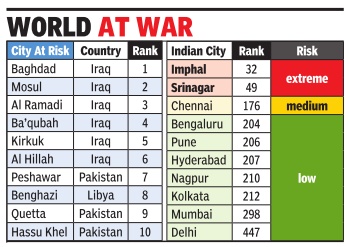
May 22 2015
2 Indian cities at high risk of terror strike
Kounteya Sinha
Two Indian cities -Imphal (ranked 32) and Srinagar (ranked 49) have been named to be at “extreme risk“ of a terrorist attack, mainly aiming to cause mass casualty and destroy public transport networks. According to an analysis of the terror risk to 1,300 commercial hubs and urban centres around the world, populations and businesses in 113 Indian cities have been identified to be at some risk -high, medium or low -of facing terrorist attacks.
The next major Indian city that faces a terrorist threat is Chennai with its risk quotient marked as medium. Bangalore is fourth among Indian cities, even though it is placed at 204th globally , followed by Pune and Hyderabad at 206th and 207th, respectively.
Around 64 cities around the world are at “extreme“ risk, with most in the Middle East and Asia, and three in Europe. While London ranked as low as at 400 due to the lack of a terror incident since the 77 bombings, Paris soared into the top 100 following the Charlie Hebdo shooting, according to Verisk Maplecroft's new Global Alerts Dashboard.
Arvind Ramakrishnan, head of Maplecroft India said, “When it comes to Imphal and Srinagar, terrorist attacks aren't on commercial targets as much as against the security forces.Public transport networks in India are also prime targets“.
Court verdicts
Extortion money payment is not terror-funding: SC
Dhananjay Mahapatra, April 10, 2021: The Times of India
In an important ruling, the Supreme Court said paying extortion money to terror groups to carry on business activities smoothly could not be termed as funding terror organisations and granted bail to a Jharkhand coal transporter who had paid huge amounts to the Tritiya Prastuti Committee (TPC), a breakaway faction of the CPI (Maoist).
A bench of Justices L N Rao and and S Ravindra Bhat granted bail to businessman Sudhesh Kedia, whose company Esskay Concast and Minerals is engaged in transporting coal on behalf of GVK Power and Godavari Commodities, in a case filed by the NIA accusing him of paying huge amounts to terror organisation TPC.
The NIA, in its 2018 chargesheet against 16 people, had given details of the modus operandi of collecting levy from contractors, traders and transporters. Kedia was arrested on January 10 last year and his bail pleas were rejected by the trial court and the Jharkhand HC.
Kedia’s counsel C A Sundaram told SC that the HC had rejected his bail plea saying since he had admitted to paying extortion money, it amounted to funding the terrorist organisation.
After examining the evidence, the Justice Rao-led bench said, “Payment of extortion money does not amount to terror funding. It is clear from the supplementary chargesheet and other material on record that other accused who are members of the terrorist organisation have been systematically collecting extortion amounts from businessmen in Amrapali and Magadh areas”. The SC said paying extortion money and meeting members of a terror organisation for that purpose couldn’t implicate a person as a conspirator for raising funds for the unlawful outfit.
Terror propagandists lethal too: HC
Terror propagandists lethal too, says HC, May 21, 2017: The Times of India
Propagandists for terror are as lethal as those who use bullets, the Delhi high court has observed, rejecting bail plea of two men.
Justice Ashutosh Kumar recently dismissed the bail applications of Asif Bashiruddin Shaikh and Akbar Ismail Choudhary , accused of being part of the media cell of terror group Indian Mujahedeen.
HC said it was not inclined to grant the relief at a stage when the trial court is yet to finish examining all the 610 witnesses.
The lawyer for the two accused had claimed that the role attributed to them by the prosecu tion is that they were part of IM's media cell which sent out threat emails after the blasts which claimed 27 lives and injured 135.
Urging HC to take note, the accused said they had moved the high court for bail for the first time now since being arrested in 2008. They arguing that it could take a substantial amount of time for the trial to finish since till date only 221 out of the 610 witnesses have been examined.
When the accused tried to play down their alleged role saying were at worst only part of the media cell, HC said, “Dissemination of propaganda in such cases was more lethal than the use of bullets or detonating of an IED.“
Fatalities Related to Terror
2005-16, i) J&K; ii) All India
2016 TERROR-RELATED FATALITIES IN J&K REACH 5-YEAR HIGH Oct 12 2016 : The Times of India
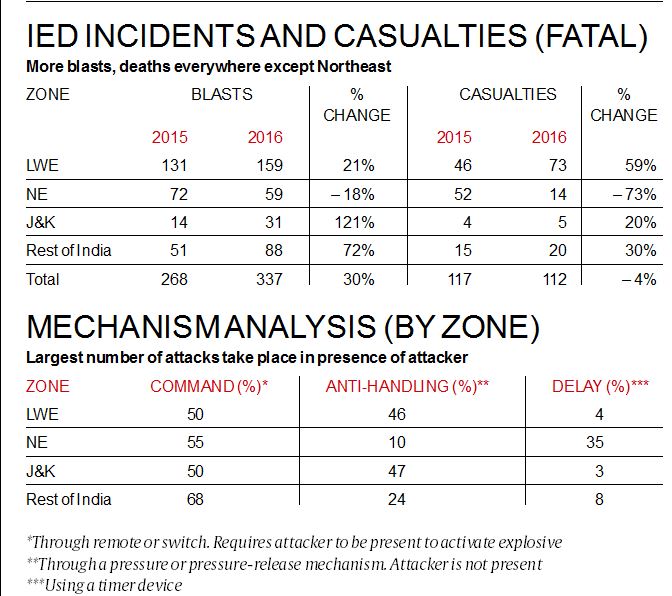
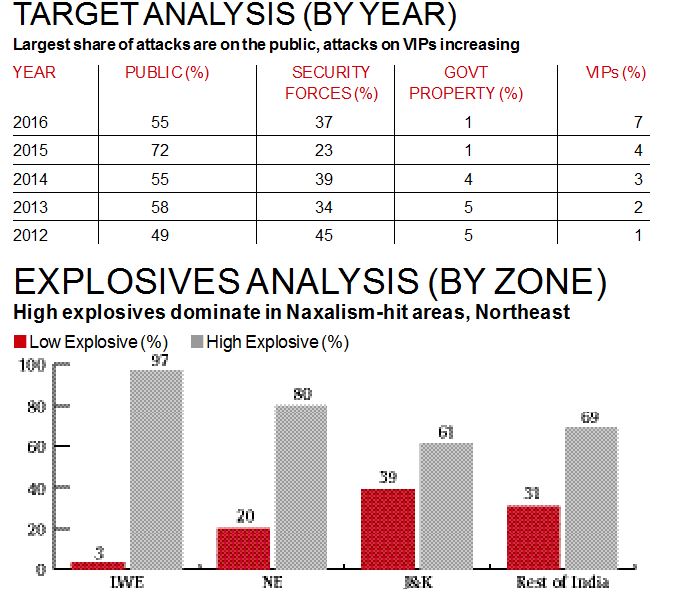
The total fatalities (civilians, security forces and terrorists) linked to terror incidents in Jammu & Kashmir is 207 for the period between January and Oct 2016--highest since 2010. The comparison of terror fatalities in Jammu & Kashmir with the rest of the country also shows that J&K's share in total fatalities is on a rise
See graphics
Fatalities Related to Terror, 2005-16
IED incidents and casualities, region-wise. The Bombshell, the annual report of the National Bomb Data Centre (NBDC) of the National Security Guard (NSG)
Use of explosives, region-wise. The Bombshell, the annual report of the National Bomb Data Centre (NBDC) of the National Security Guard (NSG)
Media coverage
1994-2019
Every day, there are jarring pieces of information through electronic and print media that many innocent, defenceless people, particularly poor, politicians, statesmen, government officials, police officials, Army personnel inclusive of the jawans belonging to Border Security Force have been mercilessly gunned down.”
“No one can deny these stark facts and naked truth by adopting an ostrich like attitude completely ignoring the impending danger. Whatever may be the reasons, indeed there is none to deny that.”
These two paragraphs were not penned after the February 14 terrorist attack on a CRPF convoy that left 40 men dead and outraged India.
This was said by the Supreme Court on March 11, 1994, nearly 25 years ago, while upholding the validity of Terrorist and Disruptive Activities (Prevention) Act keeping in mind the daily bloodbath resulting from terrorist activities in Punjab, J&K and other parts of India [Kartar Singh vs State Of Punjab; 1994 SCC (3) 569].
Terrorism has been controlled to a large extent in India. But the bloodbath continues in pockets of Maoist dominated tribal areas and J&K. Maoism is an ideological armed struggle against the Indian government with many sympathisers among the intelligentsia, who tacitly or overtly support their struggle and provide legal cover.
On the other hand, J&K is a classic case of Pakistan’s frustration over failed attempts to occupy it through military misadventures. Having failed in wars of 1948, 1965, 1971 and 1999 to occupy territories of Kashmir, Pakistan had been aiding, abetting and providing logistics, training, safe haven as well as arms and ammunition to militants to keep the state on the boil and engage India in a proxy war.
J&K acceded to India on October 26, 1947. But its boundaries were officially redrawn after three Indo-Pak wars and in 1972, the original ceasefire line of 1949 was rechristened Line of Control (LoC). Pakistan-aided militancy gained its first significant success when JKLF kidnapped then home
minister Mufti Mohd Sayeed’s daughter Rubaiya on December 8, 1989. The V P Singh government buckled and secured her return after five days by releasing five dreaded terrorists — Abdul Hamid Shiekh, Noor Mohd Kalwal, Javed Mohd Zargar, Mohd Altas Butt (brother of Maqbool Butt) and Sher Mohd Khan Azad.
A little over a year later, JKSLF, the students’ wing of JKLF, kidnapped then National Conference MP Saifuddin Soz’s daughter Naheed and again demanded release of five terrorists. The government again gave in to pressure but was able to contain the damage by securing her freedom by releasing only secessionist leader Mushtaq Ahmed. Soz, in his book ‘Kashmir: Glimpses of History and the Story of Struggle’, revealed the intervention of then Pakistani PM Nawaz Sharif, who told the handlers of militants to release Naheed on the ground that kidnapping was un-Islamic.
Till then, mike-wielding warriors of the electronic media, in its nascent years, had not entered the cutthroat competition for TRPs. Then came the hijacking of a Indian Airlines plane to Kandahar by pro-Pakistan Kashmiri militants on December 24, 1999. Even before the government could strategise to deal with the situation, relatives of 150-odd passengers aboard the flight thronged the PM’s residence and demanded urgent action to secure the release of those held captive on the plane.
The emotions displayed on the streets were beamed by the electronic media live into every home in the country. Given the hostile territory in which the plane was in, the Vajpayee government bowed to public pressure and agreed to release Maulana Masood Azhar, Ahmed Omar Saeed Sheikh and Mushtaq Zargar. The three dreaded terrorists, handed over to Taliban in exchange for the passengers, swiftly moved back to Pakistan, who was their mentor, guide and provider.
After the Pulwama terror attack, the electronic media whipped up a war hysteria. Social media networks were buzzing with patriotic messages. All this will stop after some time and the sacrifice of martyrs will be forgotten till the next incident. Just to recall, from 1990 to 2017, around 14,000 civilians and 5,000 security personnel have died in J&K in terror-related violence.
In the jingoism in TV studios, we lose the narrative on terrorism and forget our duties. Wife of Squadron Leader Ninad Mandavgane, who died in a helicopter crash near Badgam in J&K, touched the right notes when she said, “Slogan shouting and screaming ‘zindabad’ and ‘murdabad’ will not make any difference. If you really want to do something, join the armed forces… if that is not possible, keep your surroundings clean, don’t litter, don’t urinate in the open, and don’t harass women. Stop spreading communal hatred. Small gestures go a long way.”
She indeed had thought ahead of the Supreme Court, which in Kartar Singh case had said, “Many a time in human history, great societies have crumbled into oblivion through their failure to realise the significance of crisis situations operating within them. True, ours is a country which stands tallest even in troubled times, the country that clings to fundamental principles of human rights, the country that cherishes its constitutional heritage and rejects simple solutions that compromise the values that lie at the root of our democratic system. Each generation of mankind has considered its own perplexities and concerns to be unique and consequently their fundamental demands are more: the cry for justice, the longing for peace and the felt need for security.”
Terror suspects later acquitted/ discharged
Some representative cases
The story of Mohd Hussain Fazli and Mohd Rafiq Shah, the terror accused acquitted in the 2005 Delhi blasts after losing precious years in jail, resonates with several families across India. The aquittals of several terror suspects after years-long incarceration have time and again raised questions about the investigation carried out by various agencies.
In Maharashtra alone, for example, over 30 terror suspects have been either acquitted or discharged since 2004.“It's difficult to live with the same dignity in society once police label you a terror suspect,“ said Abdul Wahid Shaikh, a 711 suspect acquitted in 2015. Sheikh's son was two years and daughter six months old when he was arrested. “One cannot understand the trauma I went through. We were humiliated, beaten up and tortured during interrogation,“ he said.
“The state government has no system of rehabilitation. It's easy for people to say things get normal after acquittal. That's not true. I got my teaching job back but ev eryone is not that lucky. Most of those acquitted face financial problems when they want to start a new life,“ said Shaikh, who was accused of harbouring the Pakistanis who bombed the trains.
Hanif Sheikh, who came out of jail on February 2 after 13 years following his acquittal in the Ahmedabad tiffin blasts case, said he had no clue how to start life afresh. “In 2007, my mother died of shock with a prayer on her lips to see me out of jail. My wife, bedridden with depression since my arrest, succumbed a year later. My elder sister, who struggled to rear my children and fight my legal battle, died in 2009.My eldest daughter, a bright student, was forced to drop out due to non-payment of her school fees. There is no justice in pronouncing me innocent as the system has wronged me and my family ,“ he said.Sheikh used to run a garments business but it is all lost now.
Adam Ajmeri (54), who was facing the gallows until the SC acquitted him in the Akshardham attack case in 2014, said his friends and relatives turned their backs on him despite the clean chit. He could start life afresh only after two research scholars from National Law University collected Rs 7 lakh for him through crowd-funding. “No one would give me a job. My wife and six children were forced to survive on alms. I had turned suicidal when Allah sent the two good men who gave me Rs 7 lakh to start my dairy business,“ he said.
Right-wing groups accused of terrorism
The reality
Ajai Sahni | Hindutva terror is real | March 29, 2019, ISSUE DATE: April 8, 2019| India Today
The collapse of the prosecution in a succession of Hindutva terrorism cases can only diminish India’s credibility and bring disgrace to the NIA.
Given a succession of judgments in cases of Hindutva terrorism, the Samjhauta Express judgment could surprise only the incurably naïve. At present, it's not possible to evaluate the evidence at hand, but there is ample cumulative reason to believe that institutions and processes are being subverted in cases where partisan and ideological considerations connected to the present regime are involved. The prosecutorial U-turns and outcomes of the Malegaon and Ajmer Sharif blast cases, the fact that Rohini Salian, the public prosecutor in the Malegaon case, openly said that she had been pressurised to "go easy" on the accused and a Haryana Police investigator's public assertion that the prosecution sought to bury the truth in the Samjhauta Express trial, are cases in point.
It is significant, again, that a division bench of the Bombay High Court, in the cases of the killing of 'rationalists' Narendra Dabholkar and Govind Pansare by alleged Hindutva extremists, has repeatedly excoriated the investigating agencies and noted on March 14, 2019, "The same old story is repeated and we are sorry to say, it's nothing but an eyewash. By the methodology adopted, the absconding accused are not going to be arrested and for years together."
Significantly, even as the judgment on the Samjhauta Express case became public and the National Investigation Agency (NIA) clarified that the question of appeal to a higher court would be addressed only after studying its text, the Minister of Home Affairs immediately announced that there would be no appeal and no new inquiry-making it abundantly clear that the decision was political, not connected to any revaluation of the evidence or the content of the judgment and that NIA was not consulted. Crucially, where the state routinely takes the most trivial cases through the appeals process, this case, involving the death of 68 persons and injuries to at least another 50, seems to merit neither appeal nor-given the acquittal of all the accused-any new investigation. Are we then to believe that no one was responsible for this heinous crime?
The Hindutva propaganda factory has claimed that all these cases are a conspiracy to defame their cause, that there is no such thing as Hindutva or saffron terror, but let it be abundantly clear: Hindutva terror is a reality. Since 2002, at least 23 incidents have been reported, in 10 of which 133 persons were killed; in another eight, 69 were injured. Some of these cases (including those in which the accused have been acquitted) may be disputed, but there are four incidents in which Hindu extremists allegedly linked to the Bajrang Dal and (separately) the Sanatan Sanstha, have blown themselves up while manufacturing or transporting bombs-there can be little doubt at least about these. It is useful to recall that a similar accidental explosion at Burdwan in West Bengal sent the NIA on a nationwide rampage to uncover Islamist terrorist networks; but such blasts involving Hindutva cadres have failed to excite any comparable enthusiasm for wider investigation.
It takes a special genius to destroy a case in which the prime accused has twice confessed, in great detail, before a magistrate and also willingly given a boastful interview to a journalist detailing his actions, motives and connections (the NIA has not even called for this last source of evidence).
There is little difference between the NIA's persistent failure to find evidence against Hindutva terrorists and Pakistani investigators who can't find "credible evidence" against the 26/11 perpetrators and other Islamist terrorists acting openly against India. The collapse of the prosecution in a succession of Hindutva terrorism cases can only diminish India's credibility and bring disgrace to the country's 'premier' counter-terrorism investigation agency. Worse, it will immensely encourage fringe Hindutva elements who see mass murder as a legitimate instrument in their war against other communities as well as against Hindus who do not accept the dogmas these extremists invent along the way in their grab for political power.
(The writer is the executive director of the Institute for Conflict Management and the South Asia Terrorism Portal and editor of the South Asia Intelligence Review)
2006-2018
April 17, 2018: The Times of India
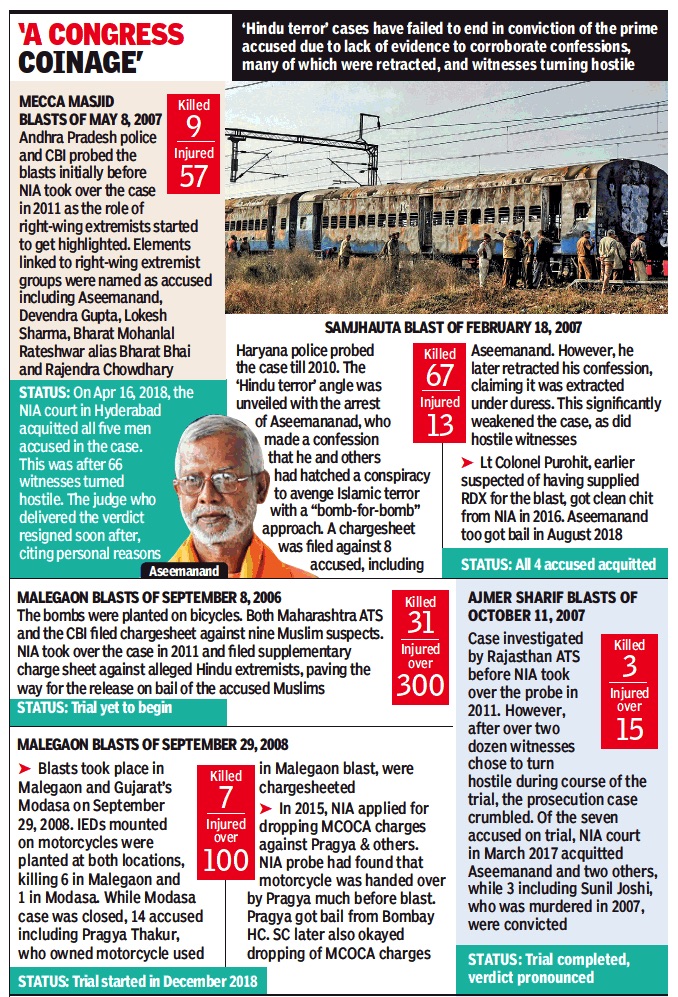
From: April 3, 2109: The Times of India
Malegaon blast 2006
37 fatalities and 125 injuries in two consecutive blasts on September 9, 2006. NIA linked the 2006 case with Hindu fringe group Abhinav Bharat and filed a chargesheet in May 2013 naming Manohar Narwaria, Rajendra Chaudhary, Dhan Singh and Lokesh Sharma (named today as well in Malegaon 2008 case). In April 2016, court discharged the 8 Muslim men in case.
STATUS: Case is at trial stage
Malegaon Blast 2008
On September 29, 2008, a blast in Malegaon left September 4 dead, 79 injured. Probing the case initially, Maha ATS claimed former ABVP activist Sadhvi Pragya Thakur, a right wing group Abhinav Bharat was behind the blast in conspiracy with Lt Colonel Prasad Purohit. NIA took over the case in April 2011 and filed a chargesheet in 2016 dropping charges against Sadhvi Pragya Singh and five others Shiv Narayan Kalsangra, Shyam Bhavarlal Sahu, Praveen Takkalki, Lokesh Sharma and Dhan Singh Choudhury.
STATUS: NIA court in December 2017 said Sadhvi Pragya and Purohit will stand trial under terror charges
2007 Mecca Masjid blast case
May 18, 2007, pipe bomb went off in 17th century Mecca Masjid, Hyderabad in which 9 killed, 58 injured. NIA chargesheeted ten persons including Aseemanand and Sunil Joshi. Joshi was shot dead by unidentified persons in Dewas, Madhya Pradesh, on December 29, 2007, while key witness Lt Col Shrikant Purohit was declared hostile in February 2018
STATUS: Court acquitted all five arrested accused of all charges on April 16, 2018:
Ajmer Dargah blast 2007
On October 11, 2007, a blast rocked the Dargah Khwaja Moinuddin Chishti in Rajasthan killing three and injuring 17. NIA filed chargesheet against Aseemanand, along with Sandeep Dange, Bhawesh Patel, Mehul, Suresh Bhai, Ramchandra Kalsangra, Sunil Joshi and Bharat Bhai
STATUS: Special NIA court on March 8, 2017 acquitted Aseemanand but sentenced to life Devendra Gupta and Bhavesh Patel. NIA didn’t challenge the acquittal
Samjhauta blast 2007
On February 18, 2017, 68 persons lost their lives when bombs went off in Samjhauta Express, a peace train between India and Pakistan near Panipat. NIA had claimed earlier that Aseemanand had confessed that he was involved in the bombing of the train, a statement he later claimed to have made under duress. US declared Arif Qasmani, a Pakistani national and alleged ‘LeT financier’, to be the chief coordinator of Samjhauta bombings, and the UN labelled him an international terrorist.
STATUS: Case is on at trial stage and NIA court is waiting to record the statement of 13 Pakistani nationals
2019/ Swami Aseemanand, Sharma, Chauhan, Chaudhary acquitted
Rajinder Nagarkoti, March 21, 2019: The Times of India
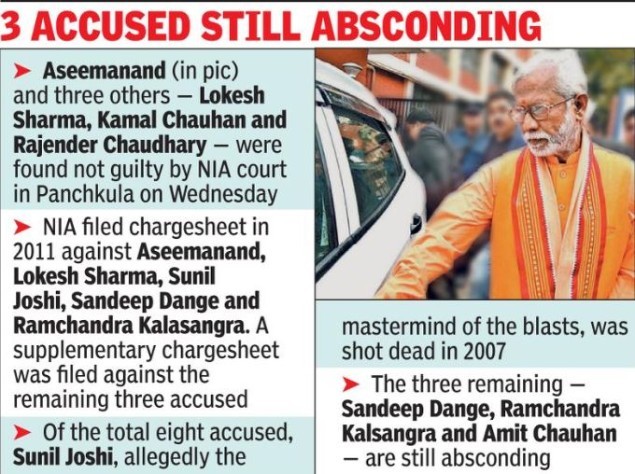
From: March 21, 2019: The Times of India
Four accused, including the radical right-wing’s Swami Aseemanand, were on Wednesday acquitted by the special National Investigation Agency (NIA) court in Panchkula in the 2007 Samjhauta blasts case.
The special NIA judge Jagdeep Singh pronounced the verdict after dismissing an application filed by a Pakistani woman, Rahila Vakil, who said she was the daughter of Muhammad Vakil, one of the Pakistanis killed in the Samjhauta blasts. She had urged court through her lawyer Momin Malik to record her statement and examine other Pakistani witnesses of the twin blasts.
Sixty-eight people, mostly Pakistanis, on board the Samjhauta Express were killed when bombs set off in two bogies of the train going from Delhi to Attari, the last station on the Indian side, on February 18, 2007, at Diwana village, near Panipat in Haryana.
The NIA will examine the court’s orders and accordingly decide on the next course of action. “The NIA had received the investigation of the case almost three years after the incident but still after several difficulties in investigations, the agency had unearthed the case. However, due to delay some of the witnesses turned hostile and we could not link the charges. We will examine the copy of the judgment and any decision on appeal will be taken after that,” NIA prosecutor R K Handa added.
The court acquitted the former R S S activist Aseemanand, Lokesh Sharma, Kamal Chauhan and Rajender Chaudhary in the case. When the special NIA judge pronounced the verdict, Aseemanand and three others were calm, revealed sources.
Of the total eight accused in the case, Sandeep Dange, Ramchandra Kalsangra and Amit Chauhan are absconding. Another accused Sunil Joshi, allegedly the mastermind of the case, was shot dead at Dewas in Madhya Pradesh on December 29, 2007.
Aseemanand and Kamal Chauhan now have no cases pending against them, but Lokesh Sharma and Rajender Chaudhary will remain in judicial custody in connection with the 2006 Malegaon blasts case. There were total three cases against Aseemanand, including 2007 Mecca Masjid blast, Ajmer Dargah blasts and Samjhauta blasts. On April 16, 2018, he was acquitted by special NIA court in Hyderabad in the 2007 Mecca Masjid blast case. Similarly, in March 2017, Aseemanand was acquitted in Ajmer Dargah blasts case.
After the verdict, Aseemanand, who was out on bail, exited the court room and thanked people and media who were outside court complex with folded hands. However, he did not comment on his acquittal and left the premises in a private vehicle.
Aseemanand’s counsel Mukesh Garg said the NIA court’s verdict had proved that his client and others had no links with these blasts.
The NIA had filed the charge sheet, running into 1,500 pages against Aseemanand and four others in the Panchkula NIA court on June 20, 2011. In the charge sheet, the agency had accused Aseemanand, Lokesh Sharma, Sunil Joshi (now dead), Sandeep Dange and Ramchandra Kalasangra alias Ramji, of murder and criminal conspiracy, under the Explosive Substances Act and Railways Act and others. Later, supplementary charge sheet was also filed against the remaining accused.
The NIA had submitted that the accused had attacked the train to take revenge against the terror attacks on Hindu temples — Akshardham (Gujarat), Raghunath Mandir (Jammu) and Sankat Mochan Mandir (Varanasi). However, the accused had pleaded they were falsely implicated in the case and their ‘confessional statements’ had been taken by the investigation agencies under duress by resorting to coercive methods.
In this case, the court had directed 13 Pakistan nationals to record their statements, but they did not turn up. These Pakistani nationals were those who were either travelling on the train on that fateful day or are next of kin who died in the blasts.
2018: Haryana does not clear prosecution of right-wingers
Ajay Sura, August 6, 2018: The Times of India
The trial of a case, where a Muslim trader from Uttar Pradesh was slapped by right-wing activists outside Hisar mosque last year in July for not chanting “Bharat Mata Ki Jai,” has not started as yet due to lack of sanction from the Haryana government for prosecution.
As the charges include Section 295-A (hurting religious feelings), permission under 196 CrPC is required from the Haryana home department, headed by chief minister Manohar Lal Khattar, for prosecution.
A case was registered against some right-wing activists on July 11, 2017 and the Hisar prosecution agency had written to the home department for sanction on August 19.
The matter came up for hearing before the trial court in Hisar on July 17, 2018, where the judicial magistrate (first class) expressed surprise over delay in sanction for prosecution and directed the prosecution agency to send a reminder to the Khattar government. The next hearing has now been fixed for September 11.
“The delay is unprecedented because normally such sanction is received within 3-4 months. The trial of the case has not commenced for want of sanction,” Vikram Mittal, counsel for the complainant told.
2018: Maharashtra group plotting to blast communal amity
The Maharashtra ATS said that it had recovered a fresh cache of arms and ammunition from the hideouts of the three people arrested for plotting bomb blasts to disturb communal amity.
ATS officials said that based on information provided by gau rakshaks Vaibhav Raut, Sharad Kalaskar and Sudhanva Ghondalekar, they recovered 11 pistols with magazines, 10 pistol barrels, an airgun, six partially made pistol bodies, three partially made magazines, 16 relay switches and one trigger mechanism battery, among other items. On Friday, ATS had said it had recovered 20 bombs and other ammunition.
While ATS had said the bombs and bomb-making material had been seized from Raut’s Nalasopara bungalow, officials refused to divulge details of the location where the firearms seized on Saturday had been kept.
CM Devendra Fadnavis told TOI the ATS operation was conducted after gathering a lot of intelligence. “The material seized is dangerous and could have been used for antisocial and terror acts,” he said. “The inquiry is still being conducted, and the motive and targets will be extracted through this inquiry,” he said. Sources said the arrested had apparently stored the cache but may not have manufactured the material. The ATS suspects there may be six to seven more sleeper cells in the state .
World ranking
2013: India 6th worst terror-hit country
Kounteya Sinha
Attacks Increased By 70% From 2012 To 2013, Toll Up From 238 To 404: India was the sixth worst-affected country by terrorism in 2013 -the other five being war zones at present. This came out in the Global Terrorism Index 2014 report which also said that the number of deaths from terrorism increased by 61% between 2012 and 2013.
There were nearly 10,000 terrorist attacks in 2013, a 44% increase from the previous year. But India witnessed a much higher increase of terrorist attacks during the same period -while terrorism increased by 70% in India from 2012 to 2013, the number of deaths increased from 238 to 404.
The report said that in India there remains significant terrorist activity including on the border between India and Pakistan. As many as 43 different terrorist groups were found to be operational in India and were categorized into three groups: Islamists, separatists and communists. They were found to have planned and carried out attacks.
Over 80% of the deaths from terrorist incidents in 2013 were recorded in just five countries: Iraq, Afghanistan, Pakistan, Nigeria and Syria. On a scale of one (low est impact of terrorism) to 10 (highest risk of terrorism) -Iraq which has emerged as the world's worst-affected country with terrorism is the only entry with a score of 10. India had a score of 7.86.
The largest year-on-year increase in deaths from terrorism was recorded between 2012 and 2013 increasing from 11,133 to 17,958. As many as 87 countries experienced a terrorist incident in 2013, slightly up from 81 in 2012. The number of countries experiencing over 50 deaths in one year hit an alltime high in 2013 at 24, five greater than the previous high of 19 countries in 2008.
About India, the Index said, “The number of attacks increased with 55 more attacks in 2013 than 2012. But the majority of terrorist attacks in India have low casualties. In 2013 around 70% of attacks were non-lethal.
“Communist terrorist groups are by far the most frequent perpetrators and the main cause of deaths in India. Three Maoist communist groups claimed responsibility for 192 deaths in 2013, which was nearly half of all deaths from terrorism in India.
“Police are overwhelmingly the biggest targets of Maoists, accounting for half of all deaths and injuries. This is mainly through armed assaults, which killed 85, and bombings and explosions, which killed 43,“ the report said.
The dispute with Pakistan over Jammu & Kashmir is the source of Islamic terrorism in India, according to the report. In 2013 three Islamist groups were responsible for around 15% of deaths in India. This includes Hizbul Mujahideen which was the only group in India to use suicide tactics in 2013.
“Islamist groups in India commonly use armed assaults targeting the police or bombings targeting private citizens. The majority of attacks occur in Hyderabad and Jammu & Kashmir,“ the report said.
Globally, four terrorist groups -al-Qaida, Boko Haram, ISIS and the Taliban were responsible for 66% of all deaths from terrorist attacks in 2013 in which the perpetrator was known.
2015: CPI (Maoist) world’s fourth deadliest terror outfit
The world witnessed 11,774 terror attacks in 2015, in which 28,328 people were killed and 35,320 injured. India was the fourth worst-affected country after Iraq, Afghanistan and Pakistan, with 43% of 791 attacks in the country carried out by Naxalites. A total of 289 Indians died in terror strikes.
Data collected by the National Consortium for the Study of Terrorism and Responses to Terrorism cont racted with the US state department revealed that Taliban, Islamic State and Boko Haram were the three deadliest terror groups globally. They were followed by CPI (Maoist), a banned outfit. The CPI(Maoist) was responsible for 343 terror attacks in 2015, killing 176 people. Taliban were involved in 1,093 strikes in which 4,512 people lost their lives, IS launched 931 attacks which claimed the lives of 6,050 people and Boko Haram was involved in 491 attacks killing 5,450 people. Kurdistan Workers' Party (PKK), which rounded off the top five in the list, was involved in 238 strikes, killing 287.
Over half the terror at tacks in India took place in four states -Chhattisgarh (21%), Manipur (12%), J&K (11%) and Jharkhand (10%).Chhattisgarh, which has been hit hard by Left-wing extremism, reported a doubling of terror attacks in 2015 -from 76 in 2014 to 167. The report said there was great diversity in the perpetratorsterrorist groups involved in attacks in the country , with 45 outfits ac tive across the country . The Naxals alone accounted for 43% of terrorist attacks in India last year. The report said the number of people kid nappedtaken hostage by terrorists and insurgent groups in India almost tripled in 2015, increasing to 862 from 305 in 2014. Of this, Naxals alone kid nappedtook hostage 707 persons last year compared with 163 in 2014. In 2014, there were no attacks in which 50 or more people were kidnapped or taken hostage while in 2015, there were seven such attacks, all of them attributed to Maoists.
Home ministry data also said that between 2010 and 2015, 2,162 civilians and 802 security personnel were killed by Naxals. Most of the dead were `tribals', often branded as police informers.
The report said that while India ranked high among countries witnessing terror attacks, the lethality of these attacks were relatively low.The number of perpetrators terrorists killed in attacks in India doubled in 2015, accounting for 20% of all deaths compared with 7% in 2014. In all, 6,924 terrorists (24%) were killed in the attacks perpetrated by them worldwide. The use of bombsexplosions as tactic for attacks was less prevalent in India than worldwide.
2017: India 3rd worst hit, after Iraq, Afghanistan
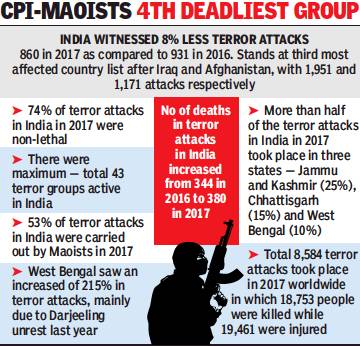
From: Neeraj Chauhan, After Iraq & Af, India worst hit in world by terror, reveals US data, September 22, 2018: The Times of India
For second year in a row, India is the third largest victim of terror attacks across the world after Iraq and Afghanistan while CPI-Maoists, which carried out 53% of the total attacks in India, is the fourth deadliest terror group after Islamic State, Taliban and Al-Shabaab, according to the data released by US department of state.
Till 2015, Pakistan was the third most affected country in the world.
The national consortium for the study of terrorism and responses to terrorism, contracted by the US department of state, has claimed that Jammu and Kashmir witnessed a 24% increase in terror attacks in 2017 and an 89% increase in the number of people killed in those attacks. Out of a total 860 terror attacks across India in 2017, 25% were reported from J&K alone.
Indian officials said that there is a major difference between terrorism in Pakistan and India. “Here in India, most of the terror activities are either sponsored by or emanating from the soil of Pakistan and its agencies and military are allowing it. On the other hand, Pakistan is now facing the attacks from terror groups it harbored and raised for decades,” an official said.
Terming Maoists as the fourth deadliest terror group in the world, the US study has stated that it was responsible for 53% attacks in India in 2017.
“The frequency of terrorist violence by Maoist extremists in India declined between 2016 and 2017 with respect to number of attacks (from 338 in 2016 to 295 in 2017); however, the number of people killed increased 16%, and the number of people injured increased 50%,” it said.
While Maoists were involved in 295 total attacks in India, only global outfits ahead of them are Al-Shabaab with 353 attacks, Taliban with 703 attacks and Islamic State with 857 attacks.
YEAR-WISE STATISTICS/ DEVELOPMENTS/ TRENDS
Terrorist attacks on India
2001-08

From: Sep 10, 2021: The Times of India
See graphic:
Terrorist attacks on India, 2001-08
2018, 19: Special Cell’s achievements
June 2, 2019: The Times of India
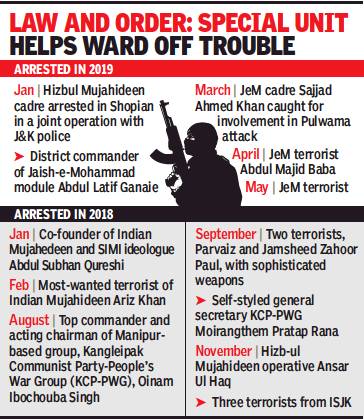
From: June 2, 2019: The Times of India
Special Cell nipped 11 terror attacks in the bud in a year
Ops Not Limited To Delhi Alone, But Also Cover J&K, Nepal
New Delhi:
In the past year, the Special Cell, Delhi Police’s anti-terror unit, carried out 11 major operations, four of them in the last four months. These were not limited to Delhi. The cell had forayed further afield, including to Jammu & Kashmir, Nepal border and northeast India.
A Delhi Police document analysing these operations indicated that many of these, being preventive in nature, had nipped terror attacks in the bud. The unit is learnt to have provided major leads in solving the Pulwama attacks and also to have played important roles in wiping out an Islamic State (Jammu & Kashmir) module and nabbing terrorists belonging to Kangleipak Communist Part-Peoples War Group, a Manipur-based outfit.
The Special Cell provided crucial inputs in the investigations of the Pulwama attacks that claimed the lives of 40 CRPF personnel after it arrested Sajjad Ahmed Khan, a resident of Tral living in Delhi under the disguise of a shawl trader, from Lajpat Rai market in March. Khan proved to be a close associate of the mastermind, Mudasir Khan. His arrests helped the investigating agencies to identify and track all the perpetrators of the terror attack and eventually to their arrest. Two modules of the Hizb-ul-Mujahideen too were busted the same month. Ahead of Republic Day earlier this year, the unit also arrested two JeM cadres, Abdul Latif Ganaie and Hilal Ahmad Bhat, in the process foiling a terror attack in which the duo had planned to lob grenades in a crowded area.
Last December, Delhi Police conducted a significant anti-terror operation in which three operatives of the Islamic State (J&K) were busted in a joint operation with the Jammu & Kashmir Police. The three men, Tahir Ali Khan, Haris Mushtaq Khan and Asif Suhail Nadaf, where detected hiding in an underground bunker in the middle of an apple orchard. They had attacked the police teams with a grenade when they approached the hideout.
The arrests of SIMI operative Abdul Subhan Qureshi and Indian Mujahideen terrorist Ariz Khan in January last year were also important steps that dented IMs plans to revive its network in India. Khan was the chief executioner of the 2008 serial blasts in Delhi, Jaipur and Ahmedabad and UP court blasts in which 165 people had been killed.
In an operation against terrorists from Manipur in September last year, the Special Cell arrested Oinam Ibochouba Singh, the self-styled acting chairman of KCPPWG. A month before this, Moirangthem Rana Pratap, general secretary of the outfit, was also arrested from a hideout in Delhi. The Special Cell is currently headed by deputy commissioners of police Pramod Kushwah and Sanjeev Yadav.
Crimes by anti-national elements
2020
Bharti Jain, Sep 16, 2021: The Times of India
‘Anti-national elements’ were responsible for 398 violent attacks in 2020, of which 240 were triggered by Left-wing extremists, 76 by jihadi terrorists, 45 by northeast insurgents and 37 by ‘other terrorists’, says the NCRB’s 2020 report. According to the section dealing with ‘crimes by anti-national elements’ in the report on ‘Crime in India’, 80 civilians and 73 security personnel were killed in confrontations/attacks by anti-nationals in 2020, while 55 Maoists, 82 jihadi terrorists and 37 other terrorists were also killed.
As many as 91 cases were registered last year in connection with attacks by jihadi terrorists, mostly in Jammu & Kashmir. This marks a 35% rise over cases registered in 2019. Of these, 70 attacks were on police stations or security camps, and 6 on other establishments. Jihadi terrorists killed 11 civilians and 14 security forces personnel, including 2 from the police, five from Central para-military forces, 6 from the Army and one special police officer (SPO). Of the 387 crimes committed by them, 356 were in J&K.
Jihadi terrorists also managed to injure 32 civilians and 22 security force personnel. However, counter-terror forces ensured that 82 jihadi terrorists were killed, even as 17 others were arrested. As for Left-wing extremists, a total 441 cases were registered relating to 240 attacks triggered by them in 2020, including 119 on police stations and camps. They killed 61 civilians and 37 security personnel. Left wing extremists too suffered 55 fatalities, of which 9 were women cadres. A whopping 554 Maoists were arrested while 327 surrendered.
Northeast insurgents triggered 45 attacks during 2020 (down from 110 in 2019), killing three security personnel . At least 46 insurgents were arrested.
